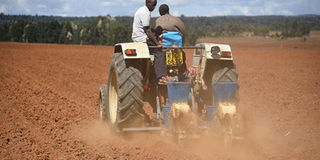Scale up climate-smart farming for food security, higher incomes

Workers plough a maize farm in Uasin Gishu County on May 7, 2019. Farmers must adopt smart farming technologies for improved productivity. PHOTO | FILE | NATION MEDIA GROUP
What you need to know:
- Mitigating climate change should be a development priority, to protect the exponentially increasing population.
- The Dutch government, for instance, is investing €39 million (Sh4.4 billion) to help Kenya to entrench climate-smart agriculture.
The long-term prospects of Kenya recovering from its frequent cycle of droughts are growing dimmer.
Delayed rains and rising temperatures have left more than a million people in marginal agricultural and pastoral areas fighting for survival due to food and nutrition deficits.
Poor rains have interfered with the regular planting cycle and reduced pasture in pastoral areas, according to the latest Famine Early Warning System Network (Fews).
CLIMATE CHANGE
Essentially, Kenya is increasingly feeling the effects of climate change. As temperatures continue to rise, climate shocks, including droughts and floods, are expected to be more frequent.
Mitigating climate change should be a development priority, to protect the exponentially increasing population — to 65 million by 2030 and 85 million by 2050, by World Bank estimates.
Our survival kit includes implementing climate mitigation and resilience interventions to increase agricultural productivity and improve value chains. There’s no shortage of funding for this.
INVESTMENT
The Dutch government, for instance, is investing €39 million (Sh4.4 billion) to help Kenya to entrench climate-smart agriculture.
The project, being implemented in Kenya, Tanzania and Uganda by the Dutch NGO SNV, in partnership with Wageningen University and Research, CGIAR and others, seeks to scale up adoption of smart agricultural innovations and technologies to mitigate the effects of climate change.
It is effecting Kenya’s Climate Smart Implementation Framework 2018-2027, which the government launched last October to transform the agricultural sector by helping farmers to adopt climate-smart practices to reduce their dependence on rain-fed agriculture.
A major focus of the programme is to improve the value chains of selected food crops, including Irish potatoes, cereals, pulses and green grams.
Case studies on Irish potatoes demonstrate how much local farmers lose by sticking to old production technologies, including waiting for the rains to support their production.
While the Netherlands achieved a record output of 52.6 tonnes of potatoes per hectare, Kenya did 7.9 tonnes — or just 15 per cent of Dutch farmers’ yield.
PRODUCTION
Kenya is one of the 10 largest producers of potatoes in Africa, but its efficiency is relatively low. South Africa, for instance, produces an average of 36 tonnes per hectare and the second-best, Egypt, 26 tonnes. At 13.8 tonnes per hectare, Ethiopia is close to the continental average (13 tonnes).
The Irish potato is the second-most important food for Kenyans after maize, but is considered more significant to improving the livelihoods of farmers because of its diverse uses as family food and in agro-processing industries (such as for potato chips and crisps). These value-added activities improve incomes for farmers.
Considering the average annual consumption of 25 kilogrammes per Kenyan, a hectare of Irish potatoes can support 316 consumers. Compare this to a hectare of a Dutch farm, which can support more than 2,000 Kenyans.
With climate-smart agriculture, a hectare of potatoes would support a much higher number of consumers, substantially increase incomes for producers and expand agro-processing industries.
TAKE ACTION
The cost of inaction would be catastrophic. It’s already apparent in Kenya’s spending on food imports, whose cost more than doubled from $504 million (Sh50 billion) in 2005 to $1.3 billion (Sh130 billion) in 2016, according to the Food and Agriculture Organisation’s “2018 World Food and Agriculture Pocket Book”.
Kenyan farmers can grumble that they continue losing the food market to foreigners. Traders are increasingly sourcing cheaper maize, sugar, potatoes, eggs, fruits, fish and other consumer goods from South Africa, Tanzania, Uganda, China and other countries than they get from local suppliers.
This could continue to haunt local producers and deplete Kenya’s foreign exchange reserves unless there’s a concerted effort to improve agricultural value chains and expand opportunities for climate-resilient production.
Mr Warutere is a director of Mashariki Communications. [email protected]





